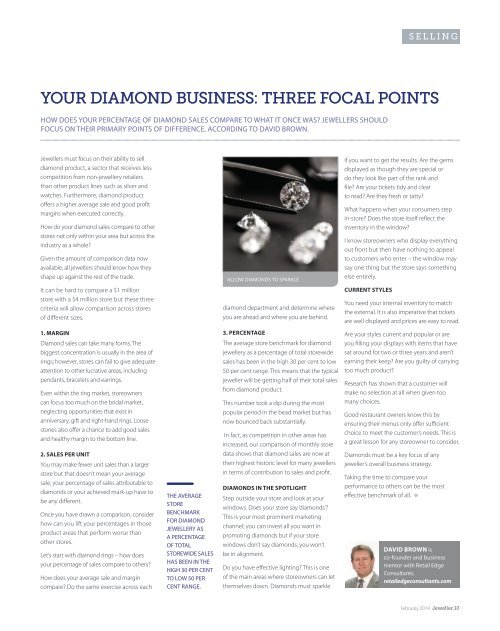Jeweller - February 2019
Create successful ePaper yourself
Turn your PDF publications into a flip-book with our unique Google optimized e-Paper software.
SELLING<br />
YOUR DIAMOND BUSINESS: THREE FOCAL POINTS<br />
HOW DOES YOUR PERCENTAGE OF DIAMOND SALES COMPARE TO WHAT IT ONCE WAS? JEWELLERS SHOULD<br />
FOCUS ON THEIR PRIMARY POINTS OF DIFFERENCE, ACCORDING TO DAVID BROWN.<br />
<strong>Jeweller</strong>s must focus on their ability to sell<br />
diamond product, a sector that receives less<br />
competition from non-jewellery retailers<br />
than other product lines such as silver and<br />
watches. Furthermore, diamond product<br />
offers a higher average sale and good profit<br />
margins when executed correctly.<br />
How do your diamond sales compare to other<br />
stores not only within your area but across the<br />
industry as a whole?<br />
Given the amount of comparison data now<br />
available, all jewellers should know how they<br />
shape up against the rest of the trade.<br />
ALLOW DIAMONDS TO SPARKLE<br />
if you want to get the results. Are the gems<br />
displayed as though they are special or<br />
do they look like part of the rank and<br />
file? Are your tickets tidy and clear<br />
to read? Are they fresh or tatty?<br />
What happens when your consumers step<br />
in-store? Does the store itself reflect the<br />
inventory in the window?<br />
I know storeowners who display everything<br />
out front but then have nothing to appeal<br />
to customers who enter – the window may<br />
say one thing but the store says something<br />
else entirely.<br />
It can be hard to compare a $1 million<br />
store with a $4 million store but these three<br />
criteria will allow comparison across stores<br />
of different sizes.<br />
diamond department and determine where<br />
you are ahead and where you are behind.<br />
CURRENT STYLES<br />
You need your internal inventory to match<br />
the external. It is also imperative that tickets<br />
are well displayed and prices are easy to read.<br />
1. MARGIN<br />
Diamond sales can take many forms. The<br />
biggest concentration is usually in the area of<br />
rings; however, stores can fail to give adequate<br />
attention to other lucrative areas, including<br />
pendants, bracelets and earrings.<br />
Even within the ring market, storeowners<br />
can focus too much on the bridal market,<br />
neglecting opportunities that exist in<br />
anniversary, gift and right-hand rings. Loose<br />
stones also offer a chance to add good sales<br />
and healthy margin to the bottom line.<br />
2. SALES PER UNIT<br />
You may make fewer unit sales than a larger<br />
store but that doesn’t mean your average<br />
sale, your percentage of sales attributable to<br />
diamonds or your achieved mark-up have to<br />
be any different.<br />
Once you have drawn a comparison, consider<br />
how can you lift your percentages in those<br />
product areas that perform worse than<br />
other stores.<br />
Let’s start with diamond rings – how does<br />
your percentage of sales compare to others?<br />
How does your average sale and margin<br />
compare? Do the same exercise across each<br />
THE AVERAGE<br />
STORE<br />
BENCHMARK<br />
FOR DIAMOND<br />
JEWELLERY AS<br />
A PERCENTAGE<br />
OF TOTAL<br />
STOREWIDE SALES<br />
HAS BEEN IN THE<br />
HIGH 30 PER CENT<br />
TO LOW 50 PER<br />
CENT RANGE.<br />
3. PERCENTAGE<br />
The average store benchmark for diamond<br />
jewellery as a percentage of total storewide<br />
sales has been in the high 30 per cent to low<br />
50 per cent range. This means that the typical<br />
jeweller will be getting half of their total sales<br />
from diamond product.<br />
This number took a dip during the most<br />
popular period in the bead market but has<br />
now bounced back substantially.<br />
In fact, as competition in other areas has<br />
increased, our comparison of monthly store<br />
data shows that diamond sales are now at<br />
their highest historic level for many jewellers<br />
in terms of contribution to sales and profit.<br />
DIAMONDS IN THE SPOTLIGHT<br />
Step outside your store and look at your<br />
windows. Does your store say ‘diamonds’?<br />
This is your most prominent marketing<br />
channel; you can invest all you want in<br />
promoting diamonds but if your store<br />
windows don’t say diamonds, you won’t<br />
be in alignment.<br />
Do you have effective lighting? This is one<br />
of the main areas where storeowners can let<br />
themselves down. Diamonds must sparkle<br />
Are your styles current and popular or are<br />
you filling your displays with items that have<br />
sat around for two or three years and aren’t<br />
earning their keep? Are you guilty of carrying<br />
too much product?<br />
Research has shown that a customer will<br />
make no selection at all when given too<br />
many choices.<br />
Good restaurant owners know this by<br />
ensuring their menus only offer sufficient<br />
choice to meet the customer’s needs. This is<br />
a great lesson for any storeowner to consider.<br />
Diamonds must be a key focus of any<br />
jeweller’s overall business strategy.<br />
Taking the time to compare your<br />
performance to others can be the most<br />
effective benchmark of all. i<br />
DAVID BROWN is<br />
co-founder and business<br />
mentor with Retail Edge<br />
Consultants.<br />
retailedgeconsultants.com<br />
<strong>February</strong> <strong>2019</strong> <strong>Jeweller</strong> 37


















